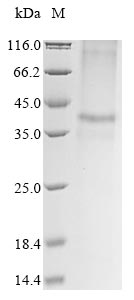Recombinant Mouse Zinc transporter 8 (Slc30a8) is produced through an in vitro E.coli expression system and includes the complete protein spanning amino acids 1 to 367. The protein features an N-terminal 10xHis tag that simplifies purification and detection processes. SDS-PAGE analysis confirms the product achieves purity levels above 85%, which appears to provide reliable performance for research work.
Zinc transporter 8 (Slc30a8) represents a key protein in regulating zinc ion movement across cellular membranes. Its role in maintaining zinc homeostasis seems critical for numerous cellular functions. The protein shows particular importance in pancreatic beta cells, where it likely contributes to insulin secretion and glucose metabolism. This makes it an increasingly important target for metabolic research.
Potential Applications
Note: The applications listed below are based on what we know about this protein's biological functions, published research, and experience from experts in the field. However, we haven't fully tested all of these applications ourselves yet. We'd recommend running some preliminary tests first to make sure they work for your specific research goals.
Mouse Slc30a8 is a eukaryotic transmembrane protein that requires precise folding, membrane integration, and zinc-binding domain formation for its functional activity. The in vitro E. coli expression system (cell-free system) provides a simplified environment without cellular compartmentalization, which is particularly challenging for transmembrane proteins that require integration into lipid membranes. While cell-free systems can produce soluble proteins, they cannot provide the necessary membrane environment for proper folding and integration of transmembrane proteins like Slc30a8. The probability of correct folding with functional zinc transport activity is very low.
1. Antibody Development and Validation
Antibody development against linear epitopes relies primarily on antigenic sequence recognition rather than native folding. This recombinant Slc30a8 serves as a suitable immunogen for generating antibodies against linear epitopes of mouse zinc transporter 8. The full-length sequence provides comprehensive epitope coverage. However, since the protein likely lacks proper membrane integration and tertiary structure, antibodies may not efficiently recognize the native, membrane-integrated form in physiological contexts.
2. Biochemical Characterization and Binding Studies
Basic biophysical characterization of the soluble protein is possible, but functional zinc binding or transport studies are not feasible. Cell-free systems cannot provide the membrane environment required for functional transmembrane protein studies. Techniques like circular dichroism can analyze secondary structure content, but the protein will lack the proper membrane association needed for physiological zinc binding.
3. Comparative Species Analysis
This protein can be used for sequence-based comparisons and immunological cross-reactivity studies of the soluble domains. However, functional comparative analyses of zinc transport would be invalid due to the lack of proper membrane integration.
Final Recommendation & Action Plan
The in vitro E. coli expression system is fundamentally unsuitable for producing functional transmembrane proteins like Slc30a8 that require membrane integration. This recombinant protein is primarily suitable for antibody development against linear epitopes (Application 1) and basic characterization of soluble domains (limited aspects of Application 2). Transmembrane protein interactions require proper membrane topology and context that cannot be achieved in cell-free expression systems. For reliable zinc transporter research, use mammalian expression systems with proper membrane environments or purified membrane preparations that support correct protein folding and activity. Begin with basic biophysical characterization to assess the protein's soluble properties, then proceed with linear epitope antibody development. For functional studies, consider alternative expression systems that provide the necessary membrane context for proper protein folding and zinc transport activity.






